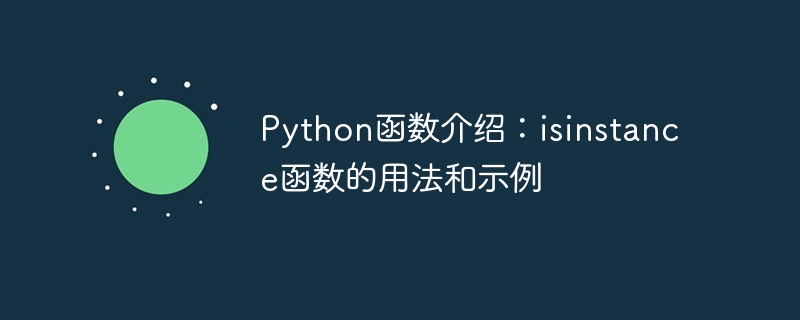Home >Backend Development >Python Tutorial >Introduction to Python functions: Usage and examples of isinstance function
Introduction to Python functions: Usage and examples of isinstance function
- 王林Original
- 2023-11-04 15:15:202109browse

Introduction to Python functions: usage and examples of isinstance function
Python is a powerful programming language that provides many built-in functions, making programming more convenient and efficient. One of the very useful built-in functions is the isinstance() function. This article will introduce the usage and examples of the isinstance function and provide specific code examples.
The isinstance() function is used to determine whether an object is an instance of a specified class or type. The syntax of this function is as follows:
isinstance(object, classinfo)
Among them, object is the object being checked, and classinfo represents the class or type to be checked.
The return value of the isinstance function is a Boolean value. If the object is an instance of the specified class or type, it returns True; otherwise, it returns False.
Here are some examples showing how to use the isinstance function:
Example 1: Check whether the object is an integer type
num = 10
if isinstance(num, int):
print("num是一个整数")
else:
print("num不是一个整数")Output result:
num是一个整数
Example 2: Check whether the object is of string type
text = "Hello world"
if isinstance(text, str):
print("text是一个字符串")
else:
print("text不是一个字符串")Output result:
text是一个字符串
Example 3: Check whether the object is of list type
my_list = [1, 2, 3]
if isinstance(my_list, list):
print("my_list是一个列表")
else:
print("my_list不是一个列表")Output result:
my_list是一个列表
Example 4: Check whether the object is an instance of a custom class
class Dog:
def __init__(self, name):
self.name = name
dog = Dog("旺财")
if isinstance(dog, Dog):
print("dog是Dog类的实例")
else:
print("dog不是Dog类的实例")Output result:
dog是Dog类的实例
In the above example, we used the isinstance function to check different types of objects, including integers , strings, lists and custom classes. By using the isinstance function, we can easily determine the type of an object and perform different operations based on different types.
In addition to determining whether the object is an instance of a certain class or type, the isinstance function can also accept a tuple as the classinfo parameter. In this case, the isinstance function checks whether the object is an instance of any class or type in the tuple. Here is an example:
Example 5: Check if an object is an instance of a tuple or list
my_tuple = (1, 2, 3)
if isinstance(my_tuple, (tuple, list)):
print("my_tuple是元组或列表的实例")
else:
print("my_tuple不是元组或列表的实例")Output result:
my_tuple是元组或列表的实例
Through the above example, we can see isinstance Flexibility of functions to check multiple classes or types simultaneously.
Summary:
The isinstance function is a very useful function provided by Python, which can be used to determine whether an object is an instance of a specified type or class. By using the isinstance function, we can easily determine the type of object and perform different operations based on different types. In programming, the isinstance function can help us better handle object type judgment and improve the readability and maintainability of the code.
I hope this article will help you understand and use the isinstance function. Learning and mastering the isinstance function will make your Python programming more efficient and convenient.
The above is the detailed content of Introduction to Python functions: Usage and examples of isinstance function. For more information, please follow other related articles on the PHP Chinese website!

